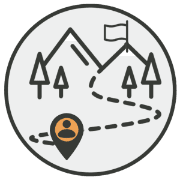Learning Trajectories


Learning trajectories help us understand how children think and learn about STEM topics and at the same time, how to support progressions in child thinking and learning. Research-based learning trajectories have 3 parts: a goal, a developmental progression, and instruction.

Parts of a Learning Trajectory
Learning trajectories are the natural, predictable paths along which children’s thinking and learning develop. There are three parts:

Goal
The goal of a learning trajectory is the target – what the child will be able to do. Each goal is one in a series of subsequent goals.

Progressions
The developmental progression of skills starts at the child’s current skill level and ends at the goal, passing through intermediate goals on the way to the goal. Progressions describe paths most children follow as they develop more sophisticated levels of thinking. Think of them as a guidebook called “What to Expect When Children Are Learning”.
STEMIE uses consistent terms to describe the levels of thinking across all of the learning trajectories. These are some you will see often:
-
Noticer – shows awareness of something/someone/event, using any of the senses
-
Explorer – engages with something with any of the senses
-
Recognizer – shows awareness that something/someone/event was encountered before and is familiar
-
Distinguisher – acknowledges the difference between two or more things/people/events
-
Identifier – verifies the identity of something/someone/event
-
Evaluator – checks how something turned out and considers what improvements could be made

Teaching
Teaching is intentional planning and delivery of activities that help the child progress through the set of skills. Teaching must always consider the environment and the materials used, with responsive adaptations made for children with disabilities.

